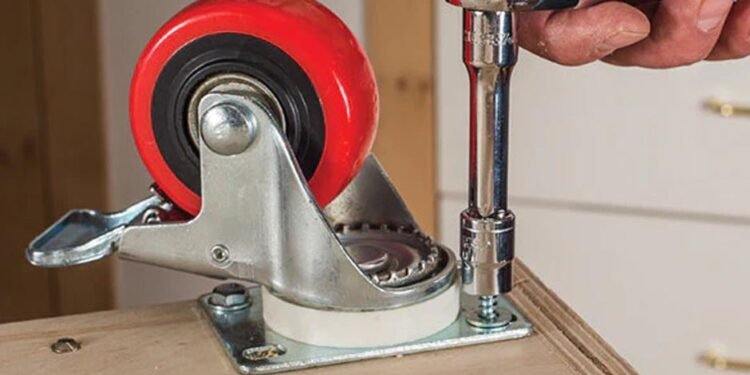Casters, those seemingly simple but immensely functional wheels attached to various objects, play a pivotal role in modern industries and everyday life. From office chairs to heavy machinery, casters facilitate mobility and efficiency. We’ll delve into the world of casters, exploring their types, applications, and the technology behind them while highlighting places to buy casters online.
Unlocking the Realm of Casters: Types, Applications, and Technological Innovations
Types of Casters
Casters come in various types, each designed for specific purposes. Standard casters, often found on office chairs and light furniture, feature a simple wheel and swivel mechanism. On the other hand, industrial casters are built to withstand heavy loads and harsh environments. They often incorporate reinforced materials and larger wheels for stability.
Another common type is the swivel caster, which allows for multidirectional movement, making it ideal for maneuvering in tight spaces. Fixed casters, in contrast, provide stability and are often used in conjunction with swivel casters to achieve balanced mobility.
Specialized casters include shock-absorbing casters for delicate equipment, heat-resistant casters for industrial ovens, and dual-wheel casters for increased weight capacity. Each type serves a unique function, contributing to the overall efficiency of diverse applications.
Applications Across Industries
Casters’ versatility makes them indispensable across various industries. In manufacturing, heavy-duty casters support the movement of machinery and materials, enhancing productivity and safety. Healthcare facilities rely on medical casters to easily transport equipment and patients, ensuring efficient operations and patient care.
Retail environments utilize casters for displays and mobile racks, enabling quick reconfiguration and space optimization. Hospitality and event industries benefit from caster-equipped furniture, allowing for swift setup and rearrangement of seating arrangements. Even in households, casters on furniture and appliances simplify cleaning and rearranging spaces.
Technology and Innovation
Advancements in caster technology continue to enhance their functionality and durability. High-quality materials like nylon, polyurethane, and rubber offer superior strength and resilience. Ball bearings and precision engineering in caster mechanisms ensure smooth and quiet operation, reducing friction and wear.
Innovations like locking mechanisms and swivel locks provide added control and stability, particularly in environments where precise positioning is critical. Ergonomic designs in caster handles and grips improve user comfort and grip, reducing fatigue during prolonged use.
Environmental Considerations
As sustainability gains importance, eco-friendly caster options are emerging. Manufacturers are using recycled materials and designing casters for energy efficiency. Low-friction casters reduce energy consumption, contributing to greener operations in industries like logistics and transportation.
Additionally, durable and long-lasting casters minimize waste by reducing the need for frequent replacements. Companies also focus on recyclability and responsible disposal of caster components, aligning with global environmental initiatives.
Maintenance and Care
Proper maintenance is essential for maximizing caster lifespan and performance. Regular cleaning and inspection remove debris and prevent buildup, ensuring smooth rolling and reduced wear. Lubrication of bearings and moving parts minimizes friction, extending the caster’s life and promoting efficient operation.
Adjusting caster height and alignment as needed maintains stability and prevents uneven wheel wear. Replacing damaged or worn casters prevents safety hazards and maintains equipment integrity. Following manufacturer guidelines for maintenance schedules and procedures optimizes caster functionality and longevity.
Innovative Features and Customization
Modern casters offer a range of innovative features and customization options to meet specific needs. Anti-static casters are designed for environments sensitive to electrostatic discharge, such as electronic manufacturing facilities, reducing the risk of damage to equipment. Noise-reducing casters feature unique materials and designs that minimize noise pollution, making them ideal for quiet environments like libraries and hospitals.
Customizable casters allow for tailored solutions, with options for wheel material, size, and load capacity. Brake systems, including foot-activated and total-lock brakes, offer added control and safety, particularly in applications requiring stationary positioning. Height-adjustable casters accommodate varying surface levels, ensuring stability and maneuverability on uneven terrain.
Safety Considerations and Standards
Safety is paramount when using casters, especially in industrial and commercial settings. Adhering to safety standards and guidelines, such as those set by organizations like ANSI (American National Standards Institute) and OSHA (Occupational Safety and Health Administration), is crucial. Load ratings must be respected to prevent overloading and potential accidents.
Regular inspections of casters and equipment ensure proper functioning and identify any signs of wear or damage. Training personnel on adequately handling and using casters reduces the risk of injuries and equipment damage. Implementing safety protocols, such as wearing appropriate footwear and using safety guards, enhances workplace safety when working with caster-equipped machinery.
Future Trends and Outlook
Looking ahead, the future of casters lies in advanced materials, intelligent technologies, and sustainable practices. Lightweight yet durable materials like carbon fiber are being explored for caster construction, offering strength and efficiency while reducing overall weight. Integrating IoT (Internet of Things) capabilities into casters enables real-time monitoring of performance metrics, enhancing predictive maintenance and operational efficiency.
Sustainable manufacturing practices, including eco-friendly materials and energy-efficient production processes, are driving the development of greener casters. Circular economy principles, such as reusability and recyclability of caster components, are becoming standard practices, aligning with global sustainability goals. As industries evolve and consumer demands shift, casters will continue to grow as essential components of mobility, efficiency, and environmental responsibility in the modern world.
Casters are crucial in modern mobility and functionality across industries and everyday settings. Understanding the diverse types of casters, their applications, and technological advancements enables us to leverage their benefits effectively. As we embrace innovation and sustainability, casters continue to evolve, enhancing efficiency, safety, and environmental responsibility. Proper maintenance and care ensure optimal performance, making casters indispensable components of our dynamic world.












